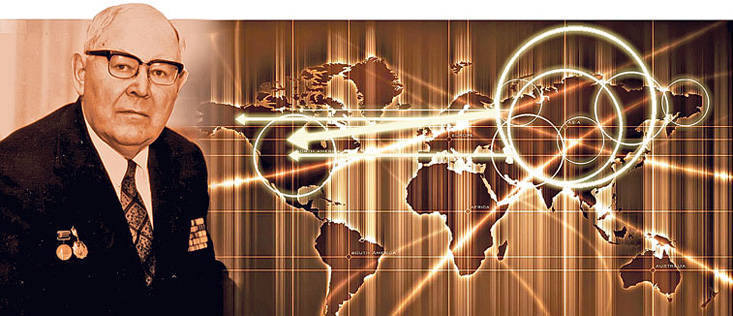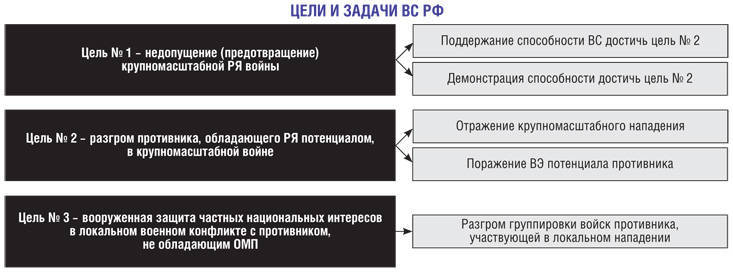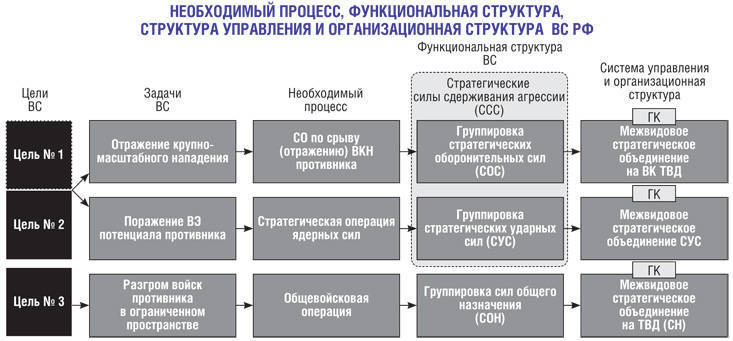In a thick fog of delusions
The number and duration of organizational upheavals of the Armed Forces of the Russian Federation has long been going wild. The vector of military reforms for more than 20 years is random, which, according to the laws of mathematics, leaves the final result near the starting point. The expected failures of many experiments on the merger, division, reassignment, renaming of military structures and institutions were predicted by far-sighted scientists even at the stage of the emergence of these ideas in the minds of reformers. Professor Ivan Yerokhin published and distributed nine books in which he warned against conducting unreasonable "experiments" on the Armed Forces. He also offered a way out of the artificially constructed labyrinth of organizational problems. It was enough to comprehend the theoretical legacy of Ivan Vasilyevich, and the gigantic state resources allocated for carrying out some “innovations” would be preserved.
By repeated unsuccessful experiments, people’s belief is undermined that someone generally knows where to go next. As soon as garrisons and headquarters hear the assurances of politicians that the military reform is complete, they understand it - the next stage is coming.
Phased advance
In order to transfer the process of creation and development of the state’s military machine to the creative channel, it must be subordinated to the classical rules of organizational construction. The latter means moving along the chain: from the goals and objectives through the construction of the technological process, through the functional structure to the management structure and, finally, to the organizational and staff design of the project (Yu. V. Krinitsky. "Scientific conceptual approach to the organization of the East Kazakhstan region", " CTP, 2013, No. 1).

Ivan Erokhin (1923 – 2012), Honored Scientist of the Russian Federation, Academician of the Academy of Military Sciences, Honorary Professor of the East-Kazakhstan Region, Doctor of Military Sciences, Professor of the Department of Operational Art of the East-Kazakhstan Region. Andrei Sedykh collage
I propose the passage of this chain not from the end to the middle (the favorite practice of impatient reformers), but with the exact observance of all its logical procedures.
So, the first and still not clearly meaningful stage is the definition of the objectives of the Armed Forces in a modern war (Fig. 1).
Figure 1

In total, it is possible to name three integral goals, for the achievement of which the Russian Armed Forces are needed.
Objective number 1 - non-admission of war.
Target number 2 - a decisive defeat of the enemy, having a nuclear missile potential, in a large-scale war.
Objective No. 3 is the armed defense of private national interests in a local war (armed conflict) with an adversary who does not possess weapons mass destruction.
Taking beyond the scope of further consideration of domestic military conflicts, "color revolutions" and civil wars, we note the fact that there can be no fourth goal for the RF Armed Forces.
We emphasize two important points.
The first is that there can be no “small” war between Russia and a developed nuclear-missile power. Firstly, there are mutual obligations between the states of the NATO bloc on collective armed protection of interests. Consequently, one will have to fight not even with one highly developed power, but with their organized group. Secondly, none of the participants in the military conflict (countries, coalitions) will not give up their interests without using the entire disposable resource of forces and capabilities. Therefore, the escalation of armed conflict into larger-scale forms is predictable.
The second thesis is that in principle it is impossible to wage a large-scale war with conventional weapons for Russia. Firstly, the US military budget is many times larger than the military budget of Russia and comparable to its state budget. It means that a war with conventional means would be ruinous and obviously losing for Russia. Strategic nuclear potential is the only factor with which our aggressive opponents are forced to reckon. Losing the war, any country with strategic nuclear forces will definitely use them. However, this provision is enshrined in the Military Doctrine of the Russian Federation, which means it is not subject to discussion.
Between the objectives of the sun there is a relationship. What is it?
A large-scale attack can be prevented only by convincing an opponent that he is guaranteed a decent “surrender” - an answer to which the aggressor “disagrees”. In other words: with an obvious readiness and ability to achieve defenders of the goal No. 2, the goal No. 1 is automatically achieved. The ability to guarantee unacceptable damage to an aggressor during a large-scale war is a necessary and sufficient condition for deterring a military conflict.
At the same time, the containment of a large-scale nuclear missile war does not insure the nuclear missile power against local military conflicts. Examples of this in the newest stories there are: the USA - Yugoslavia, the USA - Iraq, the USSR - Afghanistan, Russia - Georgia, etc. Therefore, setting the goal No. 3 in front of the Armed Forces is fully justified.
We proceed to the second step of the organizational construction of the Armed Forces - the definition of the tasks before them. Tasks, as we know, are the result of decomposition of goals.
Considering large blocks, without splitting into particulars, we get the following.
Tasks that should be accomplished in the framework of achieving the goal number 1:
-maintaining the aircraft in a state of readiness and ability to effectively achieve the goal number 2;
-demonstration of the ability and readiness to achieve the goal number 2.
Tasks to be solved in the framework of achieving the goal number 2:
-reflection of a large-scale military attack on Russia;
-defeat the military-economic potential of the enemy.
The task that needs to be solved in the framework of achieving the goal number 3 is the routing of a group of troops participating in a local attack on Russia.
The order in which tasks are solved within target No. 2 may vary depending on which of the warring parties is the aggressor.
On the basis of the Russian Military Doctrine, our Armed Forces will first solve the problem of strategic repulsing a surprise attack, and then - delivering a retaliatory or retaliatory strike. For the United States, most likely, the opposite: first, a strategic offensive, and then a strategic reflection of the blow of the forces that Russia will be able to use.
Since of all the above objectives, the main for us is No. 2, then we make one significant observation. A large-scale war with a modern highly developed adversary possessing an arsenal of strategic offensive weapons will not come to Russia along the Smolensk road, trodden by Napoleon and Hitler, but through aerospace. The armed struggle (in its initial, decisive phase) will unfold not in the traditional land-sea, but in the aerospace theater of military operations unrecognized by the Russian military science.
Of all the possible strategic outcomes of the primary and main phase of the war, only when the “draw” event occurs, the struggle can proceed to the next - “tank-bayonet” stage. However, let us be realistic: the amount of weapons of mass destruction accumulated by superpowers and their high-precision carriers makes a “draw” a practically impossible fact.
The concept of an air-land-naval operation, which is carefully imposed by Western military partners, is very similar to an information provocation that guides Russian strategists and scientists on the wrong path of defense organization. In the first Iraq war (1991) and in Yugoslavia (1999), the aerospace phase of aggression was decisive and practically the only one. And all her goals are brilliantly achieved. In the second and third wars in Iraq (1998, 2003), the air-land-sea operation drew opponents into an endless sluggish guerrilla-terrorist struggle (a contingent of the Soviet Armed Forces in Afghanistan experienced this). It is unlikely that Americans will appreciate this experience as successful. But the Russian military thought easily succumbed to the information provocation (if one admits one), followed by military practice. It was in 1998 that year, after the second Iraq, we mixed the Air Force with the Air Defense Forces for joint use in the front-line zone - in that band that will never be in a modern large-scale war. And with 2003 (after the third Iraq), we thought it unnecessary to plan a strategic operation to repel the enemy's aerospace attack. We have filled the new strategic operation with land-air-sea shock-defensive content.
In more detail, what should be understood as an aerospace theater and why it is not used tank army flotilla disparate forces and front-line unification aviation, set out in the relevant open sources (Yu. V. Krinitsky. "Aerospace theater").
Having defined the tasks, proceed to the necessary process of solving them.
From the identified problems, the general technology of their solution follows (Fig. 2).
Figure 2

In a large-scale war, these are two major technological procedures.
The first is the procedure for repelling an enemy disarming aerospace attack. It allows you to save the forces of retribution for their subsequent reciprocal or reciprocal use.
The second is the procedure for the destruction of the military economic infrastructure of the enemy with all or most of the strategic nuclear forces.
The second is the main one and, in principle, in the retaliatory option, may be the only one. The obligatory result of the war is to destroy the enemy. But according to the basic natural instinct (and in the theory of organization this is a known law of self-preservation), any organized system tends to resist the destructive influence from the outside. Therefore, on the one hand, it would be nice not only to destroy the enemy, but also to survive on your own - to defend your territory, objects, people. On the other hand, successful actions of the defending power to protect its troops increase the chances of these troops to cause unacceptable damage to the enemy.
In a local war, a unified procedure for the defeat of an enemy force group in a limited space covered by a military conflict.
The process of functioning is implemented in ways of action. There are countless ways and they are selected on the basis of the concrete situation. But their external manifestation, that is, form, is quite stable in its characteristics.
In a large-scale war, it is a strategic operation to disrupt or repel a VC attack, a strategic operation of nuclear forces.
In a local war, armed conflict - a single shock-defensive, ground-air-sea operation or fighting in the hearth of the conflict.
From the identified process, the required functional structure of the aircraft follows.
Its first component, realizing the function of global defense against military attack, is the group of strategic defensive forces (SOS). Considering that it is necessary to defend oneself from the forces of VKN, this is nothing but a strategic grouping of troops (forces) of the East Kazakhstan region.
The second component that implements the function of global retribution is the grouping of strategic strike forces (CMS). This is a systematic combination of strategic nuclear land-based, sea-based and airborne forces.
In their entirety, CMS and SOS constitute the potential of the strategic forces of deterring aggression (SSS).
The third component that implements the function of defeating the enemy in a local military conflict is the grouping of general-purpose forces (CPF). In general approximation, this is the grouping of troops in the theater of operations (SN) currently provided for by the governing documents. It is both shock and defensive in one person.
The remaining two design steps are the construction of a control system and the organizational structure of the RF Armed Forces. They can be done at the same time, since they are interdependent in much the same way as the skeleton and the muscle mass of a biological individual. Specialists in the skeleton of a long-dead man exactly recreate his portrait. Similarly, the built command and control system is the skeleton on which specific military formations are mounted.
No agreement
There are different management schemes and different variants of organizational structures that can be rational for achieving the same goals. You can stop at any of the alternatives, but under the main condition that this does not contradict, but organically continues our logical chain of organizational design.
Today, the hottest disputes are underway with respect to two subjects - the specific (clan) structure of the RF Armed Forces and the operational and administrative management of the RF Armed Forces. There are a number of key and irreconcilable positions.
The first position - Armed forces troops should not only maintain organizational independence, but also rise in their status to the type of Armed Forces.
The second is that it is necessary to merge the current EKR Troops, the Air Force and even the Strategic Missile Forces into one type of aircraft, which will be called the Aerospace Forces (VKS).
Third, it is necessary to separate the operational and administrative functions of troop control.
Fourth, a concentration of operational and administrative functions in the hands of some governing bodies is needed.
Let's try to understand this variety of approaches.
The strategic military threat in the land sector forced at one time to have a strategic alliance - a group of fronts, which later became known as the grouping of troops on the KTVD. Its basis is the unification of SV. A similar threat in the water area led to the creation of a strategic alliance - a group of troops in the ATIA. It was based on fleets. Today, threats from land and sea have been relegated to the background and theaters (not legally, but in fact) have ceased to be continental or oceanic. But under the most important and top-priority strategic aerospace threat, neither the theater nor the strategic aerospace association of the Armed Forces have been created.
Such interspecific association should be. Whether it will be called, following the analogy, the grouping of troops on the VCD or the grouping of SOS is not the point. It is important that it will be included, which management authority will head it and what its powers and responsibilities will be.
The basis of the SOS should make the armies of the East Kazakhstan region. But not such as they have been created now, but the Armed Forces of the East Kazakhstan region deployed throughout the country, where there are objects of strategic strike forces that are to be protected from attacks from aerospace. There it is also necessary to include the air defense forces of other types of aircraft, which can contribute to the solution of this task. At the head of this group should be put the commander in chief - a specialist in the field of aerospace defense. Considering the time factor, when aerospace aggression will not be preceded by a strategic deployment of the parties, when a strategic operation must be planned in peacetime, and its implementation is required right now and immediately, the separation of operational and administrative functions between the two controls is illogical. It is in the aerospace sphere that unconditional centralization of planning powers, rights to lead troops during the war, and responsibility for the result after repelling aerospace aggression is needed.
In this sense, it is the commander-in-chief of the Armed Forces, who is also the commander-in-chief of the interspecific SOS strategic group in the aerospace theater of military operations, who will be the main author of the strategic operation plan, who will submit this plan to the Chief of the General Staff for approval. Only he will achieve from his subordinates the fulfillment of all elements of this plan in the course of military operations. And only he alone will answer under the law for the achieved result.
And if so, then in peacetime he will be a person interested in the combat readiness and combat capability of his troops, will take all measures for their staffing and support, for the organization of combat and operational training. And it certainly does not take the position of an outside observer or an adventurer who creates the Potemkin villages from parts of the East Kazakhstan region.
Approaching the finish line, the reader discovers that the article does not disclose the stuffing of the final organizational structure of the Armed Forces of the Russian Federation and the group of troops (forces) solving the tasks of the aerospace defense. For some reason, this is what many are waiting for; they are concentrating on this. But the internal structure of the interspecific strategic association is not the only one that is certainly true or absolutely erroneous. It may have different (and rational) alternatives. Any design error made at the last step is less catastrophic than the error introduced at the first steps (it is easy to replace the roof of the building, but to eliminate the foundation defect, you will have to disassemble the entire structure). So says the classical theory of organization. Therefore, it is very important that the final product of the design (organizational structure, management structure of the RF Armed Forces and the East Kazakhstani Armed Forces) be the result of a single logic of organizational construction, and not the initial voluntaristic attitude that will be justified in defense of someone’s interests.
Information